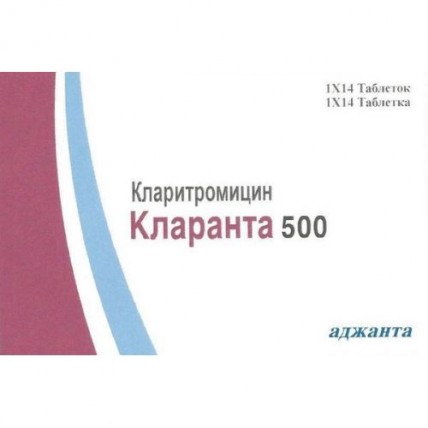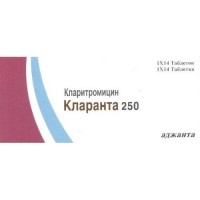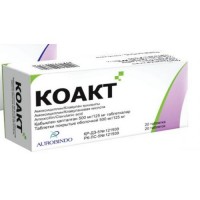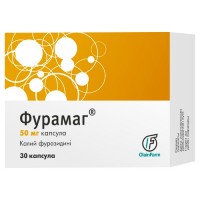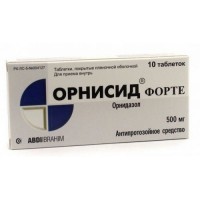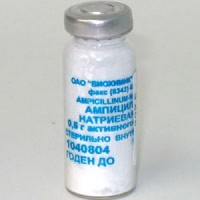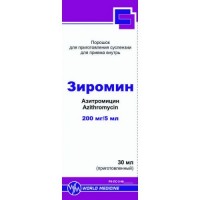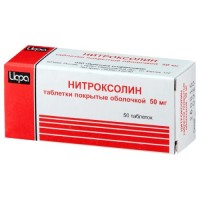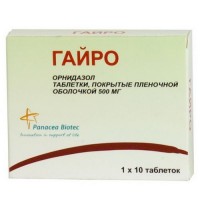Klaranta 14s 500 mg coated tablets
- $24.80
Out Of Stock
The instruction for medical use of Klaranta medicine 250 Klaranta 500 Trade name of Klarant 250 Klaranta 500 International unlicensed name Klaritromitsin Lekarstvennaya the Tablet form, coated 250 mg and 500 mg Structure One tablet contains active agent - klaritromitsin 250 mg / 500 mg, excipients: cellulose microcrystalline (Avisel rn 200), sodium lauryl sulfate, sodium of a kroskarmelloz, gipromelloz, cellulose microcrystalline, silicon dioxide colloidal, magnesium stearate, cover: instakoat Akwa-III (IA-III-40474) (polyethyleneglycol, a hydroksipropilmetiltsellyuloza, talc, titanium dioxide (E 171), quinolinic yellow WS) the Description of the Tablet, film coated yellow color, round shape, with a biconvex surface. Diameter of tablets is from 11.5 to 11.7 mm (for a dosage of 250 mg). Tablets, film coated yellow color, a capsulovidny form, with risky on one party. Length of tablets is from 19.6 to 19.8 mm, width - from 9.1 to 9.3 mm (for a dosage of 500 mg). Pharmacotherapeutic group Antibacterial drugs for system use. Macroleads, linkozamida and streptogramina. Macroleads. Klaritramitsin. The ATX J01FA09 code the Pharmacological Pharmacokinetics Later properties of intake Klaritromitsin is quickly absorbed from digestive tract. Meal reduces absorption and formation of an active metabolite 14-OH Klaritromitsin a little, but does not influence bioavailability of drug. The full bioavailability of drug is about 50%. The maximum concentration in plasma is reached within 2 hours after administration of drug. Constant level of concentration of a klaritromitsin in plasma is reached in 2-3 days and is about 1 mg/ml at the dose of 250 mg accepted each 12 hours. Elimination half-life of a klaritromitsin makes about 5-7 hours. At reception of 250 mg each 12 hours about 20% of the accepted dose are removed with urine in the form of a klaritromitsin. Linking of blood plasma with proteins makes 70% in concentration from 0.45 to 4.5 mkg/ml. Concentration of a klaritromitsin in all fabrics, except for tissue of the central nervous system, several times exceed concentration of drug in blood. The highest concentration are observed in tissue of a liver and lungs. Klarant's pharmacodynamics – a semi-synthetic antibiotic of group of macroleads. Antibacterial action of Klaranta is defined by his linking with a 5OS-ribosome subunit of sensitive bacteria and inhibition of biosynthesis of protein. Drug is highly effective against a wide range of aerobic and anaerobic gram-positive and gram-negative microorganisms, including hospital strains. The Minimum Inhibiting Concentration (MIC) of a klaritromitsin are usually twice lower, than erythromycin MIK. Klaranta is highly effective against Legionella pneumophila and Mycoplasma pneumoniae. Strains of Enterobacteriaceae and Pseudomonas, as well as the gram-negative bacteria which are not producing lactose are insensitive to Klaranta. Drug shows antibacterial activity concerning the following range of microorganisms (in clinical practice): Aerobic gram-positive microorganisms: Staphylococcus aureus, Streptococcus pneumoniae, Streptococcus pyogenes, Listeria monocytogenes. Aerobic gram-negative microorganisms: Haemophilus influenzae, Haemophilus parainfluenzae, Moraxella catarrhalis, Neisseria gonorrhoeae, Legionella pneumophila. Other microorganisms: Mycoplasma pneumoniae, Chlamydia pneumoniae (TWAR). Mycobacteria: Mycobacterium leprae, Mycobacterium kansasii, Mycobacterium chelonae, Mycobacterium fortuitum, Mycobacterium avium complex (MAC) which include Mycobacterium avium, Mycobacterium intracellulare. Beta laktamazy microorganisms do not affect Klaranta's efficiency. The majority Methicillinum - and oksatsillinrezistenty strains of stafilokokk are not sensitive to Klaranta. Klaranta is active in vitro concerning the majority of strains of following microorganisms, however clinical performance and safety of its use are not established. Aerobic gram-positive microorganisms: Streptococcus agalactiae, Streptococci (C,F,G groups) Viridans group streptococci. Aerobic gram-negative microorganisms: Bordetella pertussis, Pasteurella multocida. Anaerobic gram-positive microorganisms: Clostridium perfringens, Peptococcus niger, Propionibacterium acnes. Anaerobic gram-negative microorganisms: Bacteriodes melaninogenicus. Spirochetes: Borrelia burgdorferi, Treponema pallidum. Campylobacters: Campylobacter jejuni. Klaranta has bactericidal effect against several strains of bacteria: Haemophilus influenzae, Streptococcus pneumoniae, Streptococcus pyogenes, Streptococcus agalactiae, Moraxella (Branhamella) catarrhalis, Neisseria gonorrhoeae, H. Pylori, Campylobacter spp. Indications - infections of a lower part of airways (bronchitis, pneumonia, etc.) - infections of an upper part of airways (sinusitis, pharyngitis, etc.) - infections of skin and soft tissues (folliculites, cellulitises, erizipeloid, etc.) - the disseminated or localized mikobakterialny infections caused by Mycobacterium avium or Mycobacterium intracellulare, the localized infections caused by Mycobacterium chelonae, Mycobacterium fortuitum of Mycobacterium kansasii the Route of administration and doses In infections of a lower part of airways, an upper part of airways, infections of skin and soft tissues the recommended drug Klaranta dose for adults makes 250 mg twice a day, in heavier infections the dose is increased to 500 mg twice a day. The usual duration of treatment is 5-14 days (for community-acquired pneumonia and sinusitis the course makes 6 - 14 days). Klaranta can be applied irrespective of meal. Prevention and treatment of patients with a mikobakterialny infection: the recommended dose for adults makes 500 mg twice a day. Duration of treatment of not tuberculosis mikobakterialny tuberculosis infections is defined by the doctor individually. Side effects by the Most frequent and general side reactions at treatment klaritromitsiny are an abdominal pain, diarrhea, nausea, vomiting, and distortion of taste. These side reactions usually softly expressed are also coordinated with the known profile of safety of makrolidny antibiotics. - diarrhea, vomiting, an abdominal pain, nausea, change of flavoring feelings, disorders of sense of smell and taste - urticaria, moderately severe skin rash to an acute anaphylaxis and Stephens-Johnson's syndrome, a toxic epidermal necrolysis, medicamentous skin reaction which is followed by an eosinophilia and system manifestations (DRESS), an acne, Shenleyna-Genokh's disease - inflammation of language, stomatitis and barmy mycosis of an oral cavity, anorexia, pancreatitis, discoloration of language and teeth - thrombocytopenia, a leukopenia, a neutropenia, an eosinophilia, an agranulocytosis - dizziness, a headache, uneasiness, nervousness - concern, insomnia, nightmares, turbidity of consciousness, a hallucination and perhaps psychosis - hepatocellular and/or cholestatic hepatic dysfunction with or without jaundice and increase in liver enzymes, a liver failure - a hypoglycemia - a hearing loss, a ring in ears - ventricular premature ventricular contraction, expansion of an interval of QT, ventricular tachycardia, including polymorphic ventricular tachycardia like pirouette - an infection, vaginal infections - asthma, nasal bleeding, a vascular embolism of lungs - an esophagitis, a gastroesophageal reflux disease, gastritis, a proctalgia, stomatitis, a glossitis, an abdominal distension, dryness in a mouth, an otdyshka, a meteorism - muscular spasms, skeletal and muscular rigidity, myalgia - increase in creatinine and urea of blood - an indisposition, fever, an asthenia, a stethalgia, a fever, increased fatigue - change of a ratio albumine-globulin, increase in level of alkaline phosphatase and a lactate dehydrogenase in blood serum - pseudomembranous colitis, erysipelatous inflammation, an erythrasma - a rhabdomyolysis (in some messages about developing of a rhabdomyolysis when klaritromitsin applied along with statines, fibrata, colchicine or Allopyrinolum), a myopathy - a renal failure, interstitial nephrite - increase in a prothrombin time, urine discoloration Patients with disturbance of the immune system. At patients with AIDS and other patients with disturbance of the immune system applying high doses of a klaritromitsin a long time than it is recommended for treatment of mikobakterialny infections, it is not always possible to distinguish the side reactions connected with drug use and symptoms of the basic or associated diseases. Contraindications - hypersensitivity to makrolidny antibiotics or other components of drug - simultaneous use of a klaritromitsin and any of the following drugs: astemizol, tsizaprid, Pimozidum, terfenadin (can lead to lengthening of an interval of QT and development of cardiac arrhythmias) Including ventricular tachycardia, fibrillation of ventricles and piruetny ventricular tachycardia (torsade de pointes), ergotamine or dihydroergotamine (can lead to an ergotoksichnost), lovastatin, simvastatin (because of risk of developing of a rhabdomyolysis) - the patients who had in the anamnesis lengthening of an interval QT or ventricular cardiac arrhythmias, including piruetny ventricular tachycardia (torsade de pointes) - simultaneous use of colchicine and the R-glycoprotein or strong CYP3A4 inhibitor to patients with a renal or liver failure - the profound renal failure (at clearance of creatinine less than 30 ml/min.) - hypersensitivity to antibiotics of group of macroleads - a porphyria - pregnancy and the period of a lactation - heavy abnormal liver functions - children's and teenage age up to 18 years Medicinal interactions Klaritromitsin does not interact with oral contraceptives. Use of the following drugs is strictly contraindicated because of possible development of serious consequences of interaction. The accompanying use of a tsizaprid, Pimozidum, a terfenadin, astemizol with klaritromitsiny can lead to disturbance of a warm rhythm (lengthening of an interval of QT, ventricular tachycardia, fibrillation of ventricles and torsade de pointes). Simultaneous use of a klaritromitsin and ergotamine or dihydroergotamine is associated with signs of a sharp ergotism that it is characterized by a vasospasm and ischemia of extremities and other fabrics, including the central nervous system. Influence of other medicines on pharmacokinetics of a klaritromitsin. The medicines which are the inductors CYP3A (for example, rifampicin, Phenytoinum, carbamazepine, phenobarbital, St. John's wort drugs), can induce metabolism of a klaritromitsin. It can lead to subtherapeutic levels of a klaritromitsin and decrease in its efficiency. Besides, monitoring of plasma levels of the inductor CYP3A which can be increased because of CYP3A inhibition klaritromitsiny can be required (see also instruction for medical use of the corresponding inductor CYP3A4). Simultaneous use of a rifabutin and klaritromitsin led to increase in levels of a rifabutin and decrease in levels of a klaritromitsin in blood serum with simultaneous increase in risk of appearance of a uveitis. Efavirents, not Virapinum, rifampicin, rifabutin and rifapentine can accelerate metabolism of a klaritromitsin, reducing its concentration in blood plasma, but increasing concentration 14-ON-klaritromitsina-the expected therapeutic effect can be not reached. Etravirin Deystviye of a klaritromitsin it was weakened etraviriny, however, concentration of an active metabolite 14-ON-klaritromitsina increased. As 14-ON-klaritromitsin has hypoactivity against Mycobacterium avium complex (MAC), the general activity against this pathogen can be changed. Therefore for treatment of an IAU it is necessary to consider use of medicines alternative to a klaritromitsin. Flukonazol - change of a dose of a klaritromitsin is not required. Ritonavir. Use of a ritonavir and klaritromitsin leads to considerable oppression of metabolism of a klaritromitsin. Cmax of a klaritromitsin increases by 31%, Cmin - for 182% and AUC – for 77%. Full oppression of education 14-ON-klaritromitsina was noted. It is necessary to carry out correction of a dose at patients with a renal failure at use of a ritonavir as the pharmacokinetic amplifier together with other inhibitors of HIV protease, including atazanavir and sakvinavir. Influence of a klaritromitsin on pharmacokinetics of other medicines. Antiarrhytmic means Exist messages about development of the piruetny ventricular tachycardia which arose at simultaneous use of a klaritromitsin with quinidine or Disopyramidum. It is recommended to carry out ECG monitoring for early detection of lengthening of an interval of QT. During therapy by Klaranta it is necessary to watch concentration of these drugs in blood serum. CYP3A Klaritromitsin is CYP3A enzyme inhibitor that can lead to increase in concentration in blood plasma of the drug which is metabolized this enzyme. It can strengthen or extend its therapeutic effect and increase risk of emergence of side reactions. It is necessary to be careful at use of a klaritromitsin for the patients receiving treatment by following drugs (CYP3A substrates): to alprazola, astemizol, carbamazepine, tsilostazol, tsizaprid, cyclosporine, Disopyramidum, ergot alkaloids, Methylprednisolonum, midazolam, omeprazolum, oral anticoagulants (for example warfarin), Pimozidum, quinidine, rifabutin, sildenafit, takrolimus, terfenadin, to triazoles and vinblastine, Phenytoinum, theophylline, Valproatum. There is a probability of increase in plasma concentration of inhibitors of phosphodiesterase (the sildenafila, tadalafit and vardenafit) at their combined use with klaritromitsiny that can demand reduction of a dose of inhibitors of phosphodiesterase. There is an insignificant increase in concentration of theophylline or carbamazepine in blood plasma at their simultaneous use with klaritromitsiny. The dose decline of a tolterodin at its use with klaritromitsiny can be required. At combined use of triazolbenzodiazepines (for example, an alprazolama, midazolam, a triazolam) and tablets of a klaritromitsin it is necessary to carry out careful monitoring of the patient for timely dose adjustment. It is necessary to avoid the combined use of oral midazolam with Klaranta. For benzodiazepines which elimination does not depend on CYP3A (temazepam, nitrazepam, lorazepam) the development of clinically significant interaction with klaritromitsiny is improbable. Other types of interactions Colchicine: at simultaneous use of a klaritromitsin and colchicine the colchicine exposure can increase. It is necessary to watch a condition of patients for identification of clinical symptoms of toxicity of colchicine. Digoxin: increase in concentration of digoxin in blood serum of the patients receiving klaritromitsin together with digoxin is possible. At some patients signs of digitalis toxicity, including potentially fatal arrhythmias developed. It is necessary to control carefully concentration of digoxin in blood serum of patients at its use with klaritromitsiny. Zidovudine: decrease in equilibrium concentration of a zidovudine in blood serum is possible. Phenytoinum and Valproatum Were the spontaneous or published messages about interaction of CYP3A inhibitors, including klaritromitsin, with medicines which are not considered as metaboliziruyemy CYP3A (for example, Phenytoinum and Valproatum). Determination of levels of these medicines in blood serum at their co-administration is recommended with klaritromitsiny. It was reported about increase in their levels in blood serum. Also bidirectional medicinal interaction between Klaranta and atazanoviry, intrakonazoly, sakvinaviry is possible. Verapamil: it was reported about development of arterial hypotension, bradyarrhythmia and lactoacidosis at combined use of a klaritromitsin and verapamil. Special instructions Prolonged or repeated use of antibiotics can cause the excess growth of insensitive bacteria and mushrooms. At emergence of superinfection it is necessary to stop use of a klaritromitsin and to begin the corresponding therapy. With care it is necessary to use drug at patients with a heavy renal failure. At use of a klaritromitsin it was reported about an abnormal liver function, including the increased level of liver enzymes, and about hepatocellular and/or cholestatic hepatitis about a zhelta
oh or without it. This abnormal liver function can be heavy degree and is usually reversible. It was in certain cases reported about a liver failure with a lethal outcome which, was generally associated with serious basic diseases and/or the accompanying drug treatment. It is necessary to stop immediately use of a klaritromitsin at emergence of such manifestations and symptoms of hepatitis as anorexia, jaundice, darkening of urine, an itching or pain in a stomach. Drug has to be appointed with care to patients with a heavy liver failure and/or with a heavy renal failure. In these cases it is possible to reduce a dose by 50% or to increase an interval between administrations of drug. About development of diarrhea, from light severity to the colitis with a fatal outcome caused by Clostridium difficile (CDAD) it was reported at use practically of all antibacterial drugs, including a klaritromitsin. Strengthening of symptoms of myasthenia gravis at the patients receiving klaritromitsin is possible. It is necessary to be careful at use of drug for patients with insufficiency of function of a liver. It was reported about development of kolkhitsinovy toxicity (including with a fatal outcome) at combined use of a klaritromitsin and colchicine, especially at elderly patients, including against the background of a renal failure. With care it is necessary to apply at the same time klaritromitsin and triazolbenzodiazepines, for example, to triazoles, midazolam (see. Interaction with other medicines and other types of interactions). Because of risk of lengthening of an interval QT should be applied with care klaritromitsin at patients with the state of health connected with the raised tendency to development of lengthening of an interval of QT and torsades de pointes. Pneumonia As existence of resistance of Streptococcus pneumoniae to macroleads is possible, it is important to carry out the sensitivity test when assigning a klaritromitsin for treatment of not hospital pneumonia. In case of hospital pneumonia klaritromitsin it is necessary to apply in a combination with other corresponding antibiotics. Infections of skin and soft tissues easy and moderate severity These infections are most often caused by microorganisms of Staphylococcus aureus and Streptococcus pyogenes, each of which can be resistant to macroleads. Therefore it is important to carry out the sensitivity test. In cases when it is impossible to apply beta laktamnye antibiotics (for example, an allergy), as drugs of the first choice other antibiotics, for example, clindamycin can be applied. Now macroleads play a role only in treatment of some infections of skin and soft tissues, for example: infections, the caused Corynebacterium minutissimum (erythrasma), acne vulgaris, erysipelatous inflammation, and in situations when it is impossible to perform treatment by penicillin. At development of heavy acute reactions of hypersensitivity, such as anaphylaxis, Stephens-Johnson's syndrome, a toxic epidermal necrolysis, DRESS, Shenleyna-Genokh's disease, therapy klaritromitsiny it is necessary to stop immediately and at once to begin the corresponding treatment. Klaritromitsin it is necessary to apply with care at co-administration with CYP3A4 cytochrome enzyme inductors (see. Interaction with other medicines and other types of interactions). It is necessary to pay attention to a possibility of cross resistance between klaritromitsiny and other macroleads and also lincomycin and clindamycin. Use of any antimicrobic therapy, including a klaritromitsin, for treatment of an infection of H. pylori can lead to development of microbic resistance. Oral hypoglycemic drugs / insulin. Simultaneous use of a klaritromitsin and oral hypoglycemic drugs and/or insulin can lead to the expressed hypoglycemia. At simultaneous use of a klaritromitsin with some hypoglycemic drugs, such as nateglinid, pioglitazon, repaglinid, roziglitazon owing to CYP3A enzyme inhibition klaritromitsiny there can be a hypoglycemia. Careful monitoring of level of glucose in blood is recommended. Oral anticoagulants. There is a risk of serious bleedings and significant increase in a prothrombin time at simultaneous use of a klaritromitsin and warfarin. It is necessary to control carefully a prothrombin time at the combined use of a klaritromitsin and oral anticoagulants. GMG-KoA-reduktazy inhibitors. Simultaneous use of a klaritromitsin of a lovastatin and simvastatin is contraindicated since statines are intensively metabolized CYP3A4 and joint treatment with klaritromitsiny increases their plasma concentration that increases risk of a myopathy, including a rhabdomyolysis. Messages about a rhabdomyolysis at the patients accepting klaritromitsin with these statines were received. If treatment klaritromitsiny cannot be avoided, the course of treatment lovastatiny or simvastatiny has to be suspended for treatment klaritromitsiny. It is necessary to be careful appointing klaritromitsin with statines. In situations when simultaneous use of a klaritromitsin with statines cannot be avoided, it is recommended to appoint the lowest registered dosage of statines. Use of statines which metabolism does not depend on CYP3A enzyme can be considered (for example, fluvastatin). Pregnancy and the period of a lactation Safety of use of a klaritromitsin during pregnancy and feeding by a breast was not established. Therefore use of drug of this category of women is not recommended without careful assessment of a ratio advantage/risk. Klaritromitsin is allocated with breast milk. Use in pediatrics the Drug Klaranta is not used at patients 18 years in connection with the content of Quinolinic Yellow dye are younger. Features of influence of medicine on ability to run the vehicle or potentially dangerous mechanisms Data on influence are absent. However before control of motor transport and other mechanisms it is necessary to take into account possibility of side reactions from nervous system, such as spasms, dizziness, vertigo, hallucinations, confusion of consciousness, a disorientation, etc. Overdose Symptoms: nausea, vomiting. Treatment: gastric lavage and maintenance therapy. The form of release and packing On 14 tablets place in blister strip packaging from a film of the polyvinylchloride and printing aluminum foil varnished. On 1 planimetric packings together with the instruction for medical use in the state and Russian languages put in a pack from cardboard. To Store storage conditions in the place protected from light at a temperature from 15 °C to 30 °C. To store out of children's reach! 3 years not to apply a period of storage after the expiration date specified on packing! Prescription status According to the prescription Ajanta Pharm Limited Producer, India Ajanta the House, Charkop, Kandivli (3) Mumbai, 400067 Ph.: 91-22-66061000, e-mail: Shailesh.singh@ajantapharma.com the Name and the country of the owner of the registration certificate of Ajanta Pharm Limited, India the Address of the organization accepting in the territory of the Republic of Kazakhstan claims from consumers on quality of products: Republic of Kazakhstan, 050009, Almaty, Anosov St., 54/28 (ug. Tolya St. bi) Ph. / fax: 8 (727) 241-45-73, 277-51-46
to Develop
oh or without it. This abnormal liver function can be heavy degree and is usually reversible. It was in certain cases reported about a liver failure with a lethal outcome which, was generally associated with serious basic diseases and/or the accompanying drug treatment. It is necessary to stop immediately use of a klaritromitsin at emergence of such manifestations and symptoms of hepatitis as anorexia, jaundice, darkening of urine, an itching or pain in a stomach. Drug has to be appointed with care to patients with a heavy liver failure and/or with a heavy renal failure. In these cases it is possible to reduce a dose by 50% or to increase an interval between administrations of drug. About development of diarrhea, from light severity to the colitis with a fatal outcome caused by Clostridium difficile (CDAD) it was reported at use practically of all antibacterial drugs, including a klaritromitsin. Strengthening of symptoms of myasthenia gravis at the patients receiving klaritromitsin is possible. It is necessary to be careful at use of drug for patients with insufficiency of function of a liver. It was reported about development of kolkhitsinovy toxicity (including with a fatal outcome) at combined use of a klaritromitsin and colchicine, especially at elderly patients, including against the background of a renal failure. With care it is necessary to apply at the same time klaritromitsin and triazolbenzodiazepines, for example, to triazoles, midazolam (see. Interaction with other medicines and other types of interactions). Because of risk of lengthening of an interval QT should be applied with care klaritromitsin at patients with the state of health connected with the raised tendency to development of lengthening of an interval of QT and torsades de pointes. Pneumonia As existence of resistance of Streptococcus pneumoniae to macroleads is possible, it is important to carry out the sensitivity test when assigning a klaritromitsin for treatment of not hospital pneumonia. In case of hospital pneumonia klaritromitsin it is necessary to apply in a combination with other corresponding antibiotics. Infections of skin and soft tissues easy and moderate severity These infections are most often caused by microorganisms of Staphylococcus aureus and Streptococcus pyogenes, each of which can be resistant to macroleads. Therefore it is important to carry out the sensitivity test. In cases when it is impossible to apply beta laktamnye antibiotics (for example, an allergy), as drugs of the first choice other antibiotics, for example, clindamycin can be applied. Now macroleads play a role only in treatment of some infections of skin and soft tissues, for example: infections, the caused Corynebacterium minutissimum (erythrasma), acne vulgaris, erysipelatous inflammation, and in situations when it is impossible to perform treatment by penicillin. At development of heavy acute reactions of hypersensitivity, such as anaphylaxis, Stephens-Johnson's syndrome, a toxic epidermal necrolysis, DRESS, Shenleyna-Genokh's disease, therapy klaritromitsiny it is necessary to stop immediately and at once to begin the corresponding treatment. Klaritromitsin it is necessary to apply with care at co-administration with CYP3A4 cytochrome enzyme inductors (see. Interaction with other medicines and other types of interactions). It is necessary to pay attention to a possibility of cross resistance between klaritromitsiny and other macroleads and also lincomycin and clindamycin. Use of any antimicrobic therapy, including a klaritromitsin, for treatment of an infection of H. pylori can lead to development of microbic resistance. Oral hypoglycemic drugs / insulin. Simultaneous use of a klaritromitsin and oral hypoglycemic drugs and/or insulin can lead to the expressed hypoglycemia. At simultaneous use of a klaritromitsin with some hypoglycemic drugs, such as nateglinid, pioglitazon, repaglinid, roziglitazon owing to CYP3A enzyme inhibition klaritromitsiny there can be a hypoglycemia. Careful monitoring of level of glucose in blood is recommended. Oral anticoagulants. There is a risk of serious bleedings and significant increase in a prothrombin time at simultaneous use of a klaritromitsin and warfarin. It is necessary to control carefully a prothrombin time at the combined use of a klaritromitsin and oral anticoagulants. GMG-KoA-reduktazy inhibitors. Simultaneous use of a klaritromitsin of a lovastatin and simvastatin is contraindicated since statines are intensively metabolized CYP3A4 and joint treatment with klaritromitsiny increases their plasma concentration that increases risk of a myopathy, including a rhabdomyolysis. Messages about a rhabdomyolysis at the patients accepting klaritromitsin with these statines were received. If treatment klaritromitsiny cannot be avoided, the course of treatment lovastatiny or simvastatiny has to be suspended for treatment klaritromitsiny. It is necessary to be careful appointing klaritromitsin with statines. In situations when simultaneous use of a klaritromitsin with statines cannot be avoided, it is recommended to appoint the lowest registered dosage of statines. Use of statines which metabolism does not depend on CYP3A enzyme can be considered (for example, fluvastatin). Pregnancy and the period of a lactation Safety of use of a klaritromitsin during pregnancy and feeding by a breast was not established. Therefore use of drug of this category of women is not recommended without careful assessment of a ratio advantage/risk. Klaritromitsin is allocated with breast milk. Use in pediatrics the Drug Klaranta is not used at patients 18 years in connection with the content of Quinolinic Yellow dye are younger. Features of influence of medicine on ability to run the vehicle or potentially dangerous mechanisms Data on influence are absent. However before control of motor transport and other mechanisms it is necessary to take into account possibility of side reactions from nervous system, such as spasms, dizziness, vertigo, hallucinations, confusion of consciousness, a disorientation, etc. Overdose Symptoms: nausea, vomiting. Treatment: gastric lavage and maintenance therapy. The form of release and packing On 14 tablets place in blister strip packaging from a film of the polyvinylchloride and printing aluminum foil varnished. On 1 planimetric packings together with the instruction for medical use in the state and Russian languages put in a pack from cardboard. To Store storage conditions in the place protected from light at a temperature from 15 °C to 30 °C. To store out of children's reach! 3 years not to apply a period of storage after the expiration date specified on packing! Prescription status According to the prescription Ajanta Pharm Limited Producer, India Ajanta the House, Charkop, Kandivli (3) Mumbai, 400067 Ph.: 91-22-66061000, e-mail: Shailesh.singh@ajantapharma.com the Name and the country of the owner of the registration certificate of Ajanta Pharm Limited, India the Address of the organization accepting in the territory of the Republic of Kazakhstan claims from consumers on quality of products: Republic of Kazakhstan, 050009, Almaty, Anosov St., 54/28 (ug. Tolya St. bi) Ph. / fax: 8 (727) 241-45-73, 277-51-46
to Develop
